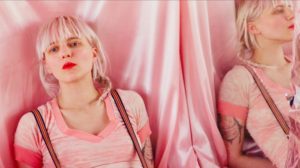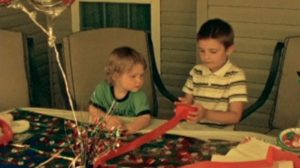It’s been a Victoria tradition for a long time, and despite the obstacles it’s facing due to COVID-19, Antimatter film festival will indeed be happening this year. Antimatter, now in its 23rd year, celebrates film and other expressions of audio/visual artistry with a non-competitive, community-oriented focus; this year features over 100 films from more than 30 countries.
Social restrictions due to COVID-19 have prompted event organizers to adopt a mostly online model of viewing, but there will still be limited in-person events at locations across Victoria.

Montreal filmmaker Kim Kielhofner’s The Coldest Day of The Year is screening at this year’s Antimatter. Kielhofner happened upon the craft while she was in school specializing in fibre art.
“I always just really loved film,” she says. “When you go to school, you get access to equipment and it’s your time to try things, and it really fit for me.”
Since 2005, Kielhofner has created more than 30 films, including The Coldest Day of The Year, a conceptual piece that “takes place in a future where a cataclysmic event has made tracing a coherent meaning of the past and recounting a narrative of the present impossible,” according to the Antimatter festival program.
Rather than using a typical plot structure for the film, Kielhofner has chosen to use an abstract framework to explore how people interact with themselves and the world at the meeting place between the inward and outward manifestations of self.
“It’s not about literal events, it’s more of a situational hypothetical setup to explore ideas about certain things, like what a person does in solitude,” she says, attributing her inspiration to the novel The Wall by Marlen Haushofer. “This woman wakes up one day and finds that there’s this invisible wall that blocks her off from the rest of the world, and she has no idea if she’s alone, or if time is still going on. The only way she can make sense of this is to focus on daily tasks of staying alive, so that book kind of led me into my work.”
The film is presented as a narrative flow of spoken-word poetry which evokes haunting feelings of loneliness and isolation, diving into the inner voice of a woman who is alone in a frozen wasteland with nothing but herself for company, while seeing fleeting ephemeral ghosts of past humanity on the horizon.
The sombre storytelling is strongly contrasted by visuals emphasizing bright colours, geometrical shapes, and flowing abstract movement. The cinematography creates striking visual impressions—a snapshot of any scene could easily be framed as an independent work of art. Kielhofner says that the contrast between a dark narrative and brightly coloured visuals is a compelling dynamic she favours.
“I always work with colours, it’s how I explore things, it’s the formal language I use,” she says. “I think my work is pretty dark, but maybe on the surface you don’t necessarily get that, so it’s a juxtaposition I like to play with.”

Oregon-based filmmaker Jennifer Hardacker’s movie Close as Brothers is screening at Antimatter this year; Hardacker says she was inspired by David Lynch’s Blue Velvet.
“I was quite young when I first saw that film, not quite 15, and I had been interested in creative storytelling in general,” says Hardacker. “I actually thought maybe I fancied myself a fiction writer, and then I realized that film worked with my brain better because I’m a visual thinker. The way [Blue Velvet] tells the story so visually… it just opened my eyes.”
Close as Brothers explores the relationship of her two sons—August is on the autism spectrum, while Ulee is considered neurotypical. This distinction didn’t make sense to the brothers as children, but over time, their differences grew more noticeable.
“[August kept teasing Ulee], telling him he was acting like a ‘real teenager’ and I would ask him, what does that mean? It had this negative connotation that real teenagers were more emotional, more interested in their friends then their family,” says Hardacker. “I thought it would be interesting to sit the two of them down to have a conversation, because it was clear that they were starting to grow apart.”
The film focuses on recognizing the diversity of each individual human being.
“We have a tendency to think that there’s one way that people should be, and [when they] don’t conform to that, we think they’re different. The important thing to remember is we’re all different, all unique,” says Hardacker. “Hopefully this will help people think about meeting people where they’re at and appreciating them for who they are, rather than how they do or don’t conform to a sense of what we would consider normal.”
This idea is encapsulated perfectly by this dialogue from the movie:
Ulee: “So do you think you should just be treated like a normal human?”
August: “No. I don’t think that anybody should treat each other like normal humans. We need to treat each other like people, not the same. You shouldn’t treat me differently because I’m autistic; you should treat me differently because I’m August.”
Antimatter
Various times, Thursday, October 15 to Sunday, October 25
Various prices and venues
antimatter.ca
